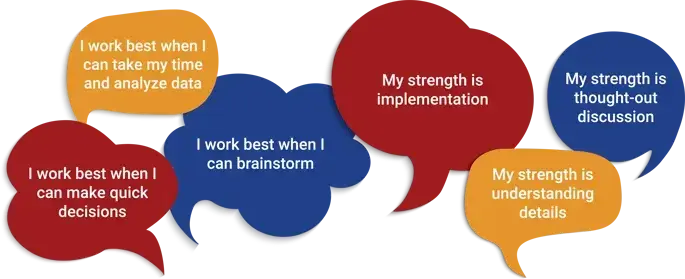If you examine almost any corporate team, you’d probably find a diverse and interesting mix of personalities. It’s what makes every team unique, right? Maybe there’s the envelope pusher and the rule-follower, the first to speak up and the one who listens intently, and the list maker and the spontaneous one. Although these differences could easily divide the group, they don’t have to. Effective teams feature a range of perspectives that can not only provide the opportunity for the group to understand perceptions other than their own, but meet the team’s overall goals in unexpected ways. However, a range of perspectives is only possible when you are hiring for personality diversity rather than by skill set and expertise alone.
You see, each team member has natural strengths—things they are good at and situations in which they thrive. These strengths are apparent to others on the team, as they are demonstrated in everyday, observable behaviors. They’re how the team shows up. The team members also have varying needs, which are not always apparent to others but can keep the team from being at its best when not met. Given that these strengths and needs almost always exist on a wide spectrum, how can the differences among individual contributors propel the collective success of the team?
The strategy squad
Let’s take a look at a strategic team at a business firm. This team has the assignment to make financial strategy recommendations for a top client. They have to research the business’s current financial situation, analyze the data for clues about how the business got there and connect the dots to devise a new strategy prior to presenting their ideas to the client in four weeks. They’ll need to leverage each other’s strengths to solve the problem, meet the deadline, and make a compelling pitch to the client.
The one who analyzes everything
Madelynn is a lover of all things Excel. Give her numbers to sort, analyze, and graph, and she is wildly productive. The research and data analysis piece of the project excites her, but she struggles with project timelines because she’s always looking for “just one more data point.” And while Madelynn will be great at painting an accurate picture of how the client’s business arrived at its current financial situation, she would panic if you asked her to speak to the client about it, as she prefers to stay behind the scenes than be front and center.
The one who thinks in big picture
Luckily for Madelynn, Alex and Tasha can jump in and help complete some important pieces of the project puzzle. Alex is the thinker on the team and has difficulty understanding how Madelynn can get lost in something like a spreadsheet full of numbers. You can find him thinking carefully after a meeting, processing everything he’s heard, and pondering how to use the information to best move forward. High-level strategy development is the perfect role on the team for him, but his creative nature sometimes tends towards reflecting rather than doing.
The one who keeps everyone on track
Enter Tasha, whose best friends are a checklist, a timeline, and a process. The thought of falling behind on a deadline makes Tasha anxious, and she is not afraid to tap team members on the shoulder and let them know she’s waiting on work from them. With her ability to easily speak her mind to her team and the urgent need to stay on schedule, Tasha can hold Madelynn accountable for taking action and relieve Alex’s overthinking by letting her know it’s time to move on to the next phase of the project. She loves making a decision.
And for the client pitch? Alex is our guy. While Tasha feels confident voicing her opinion in smaller settings, she - like Madelynn - prefers more of a behind-the-scenes role. But Alex can take his passion for the ideas and effectively translate them into a compelling story for the presentation, leaving Madelynn and Tasha to provide support in the room on an as-needed basis.

Different perspectives lead to better outcomes
As humans, we always view others through the lens of our own reality with perception casting the deciding vote on whether a team member’s behavior is a strength or a liability. Tasha can be frustrated by Alex’s lack of urgency, or she can appreciate that his deliberation of various options typically results in the best outcome for the client. Alex can ask himself all day why Madelynn prefers a calculator to a whiteboard, or he can be thankful that their passions and skills diverge in a way that keeps him away from the numbers. The more we appreciate our differences, the less we worry about our perception of deciding the battle of the “best.” Because when we allow differences to be a source of celebration rather than frustration, our teams always come out on top.
Learn more about successful teaming in The Power of Perception here.

